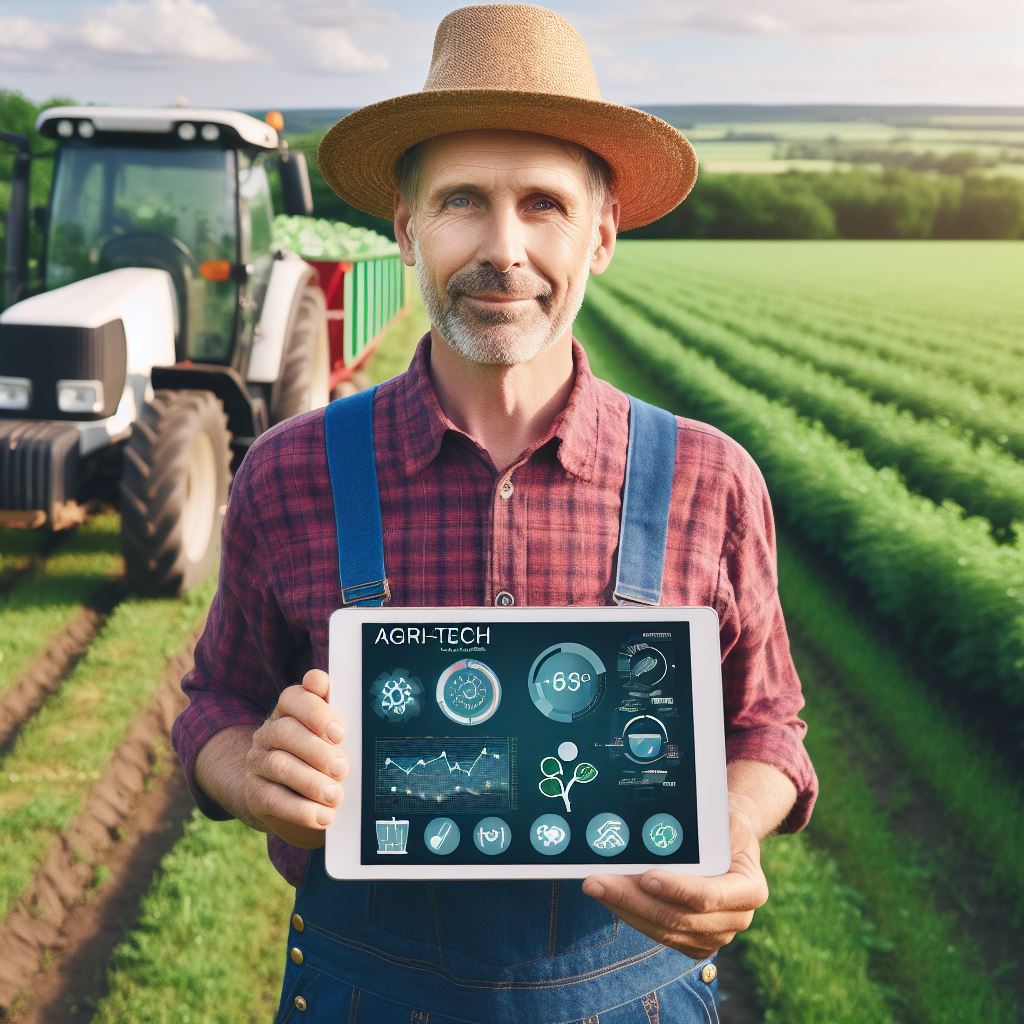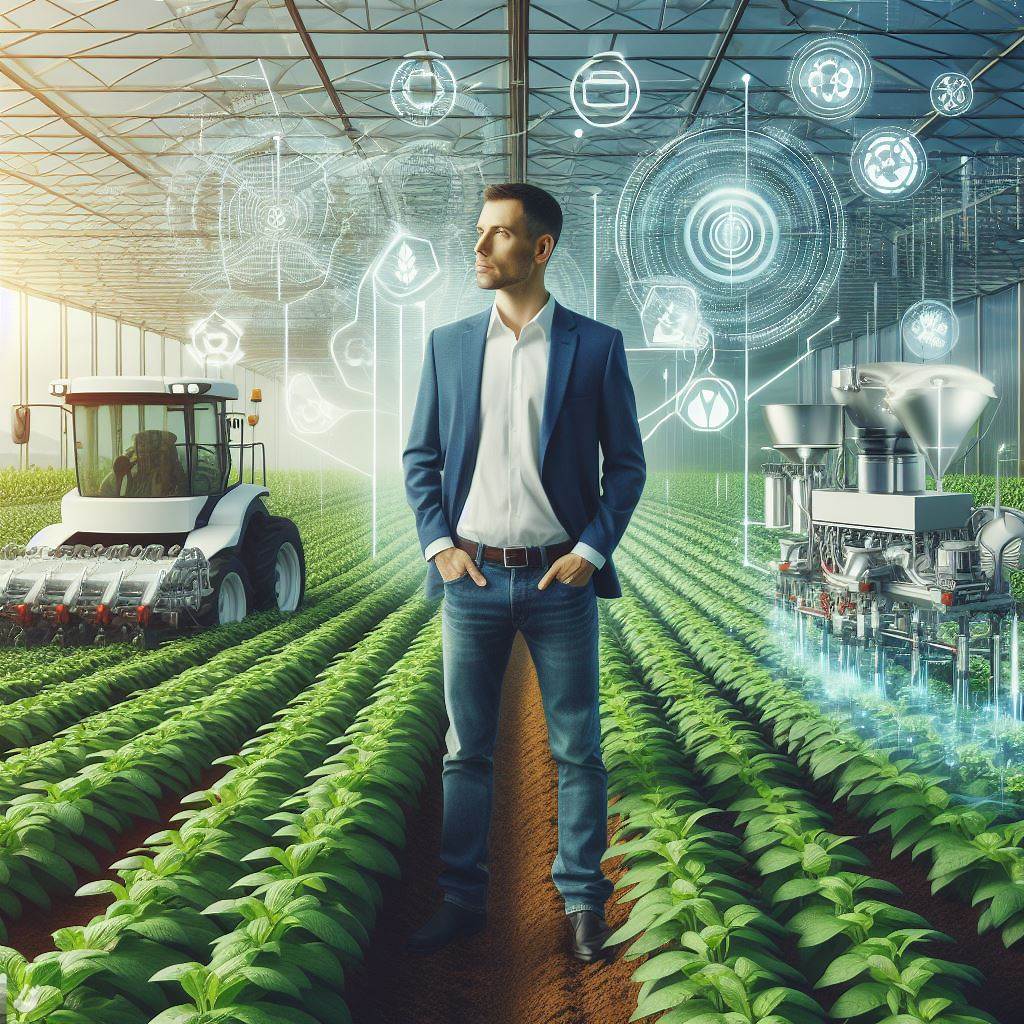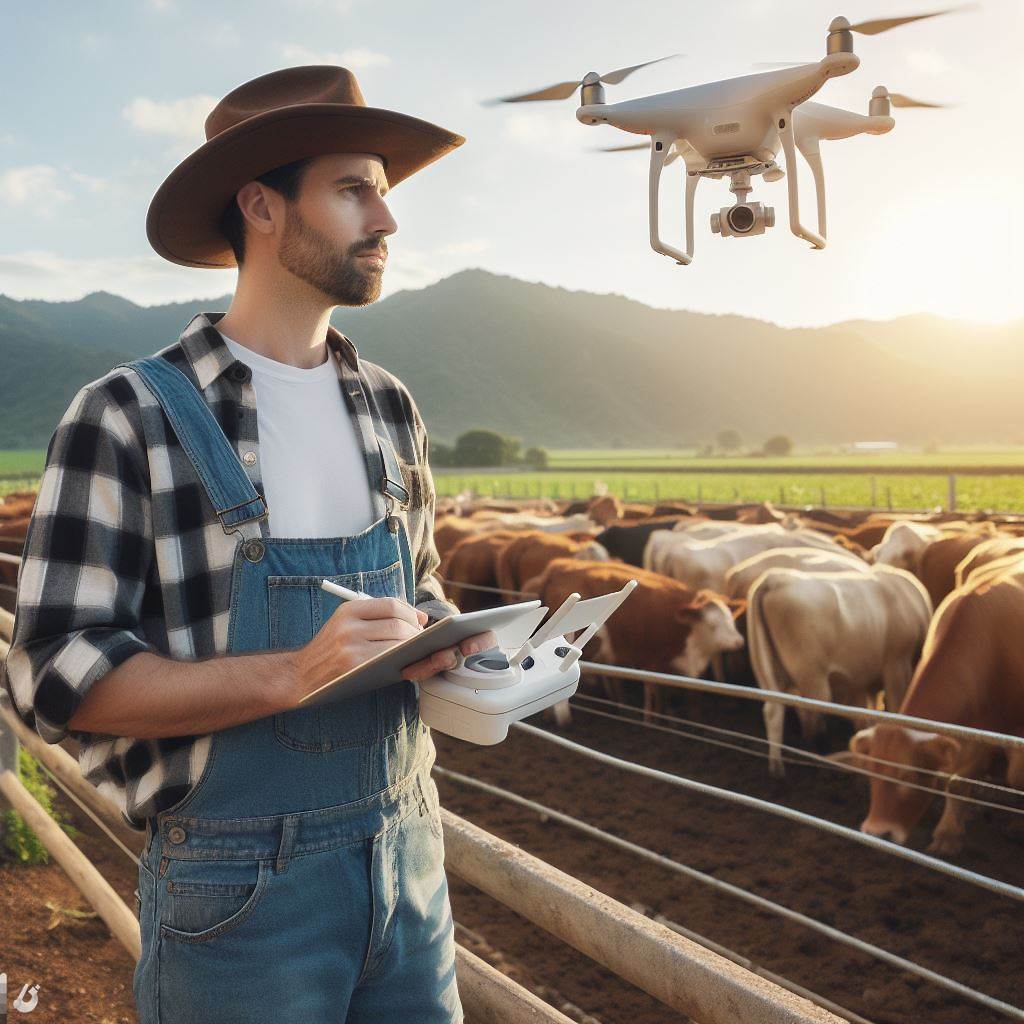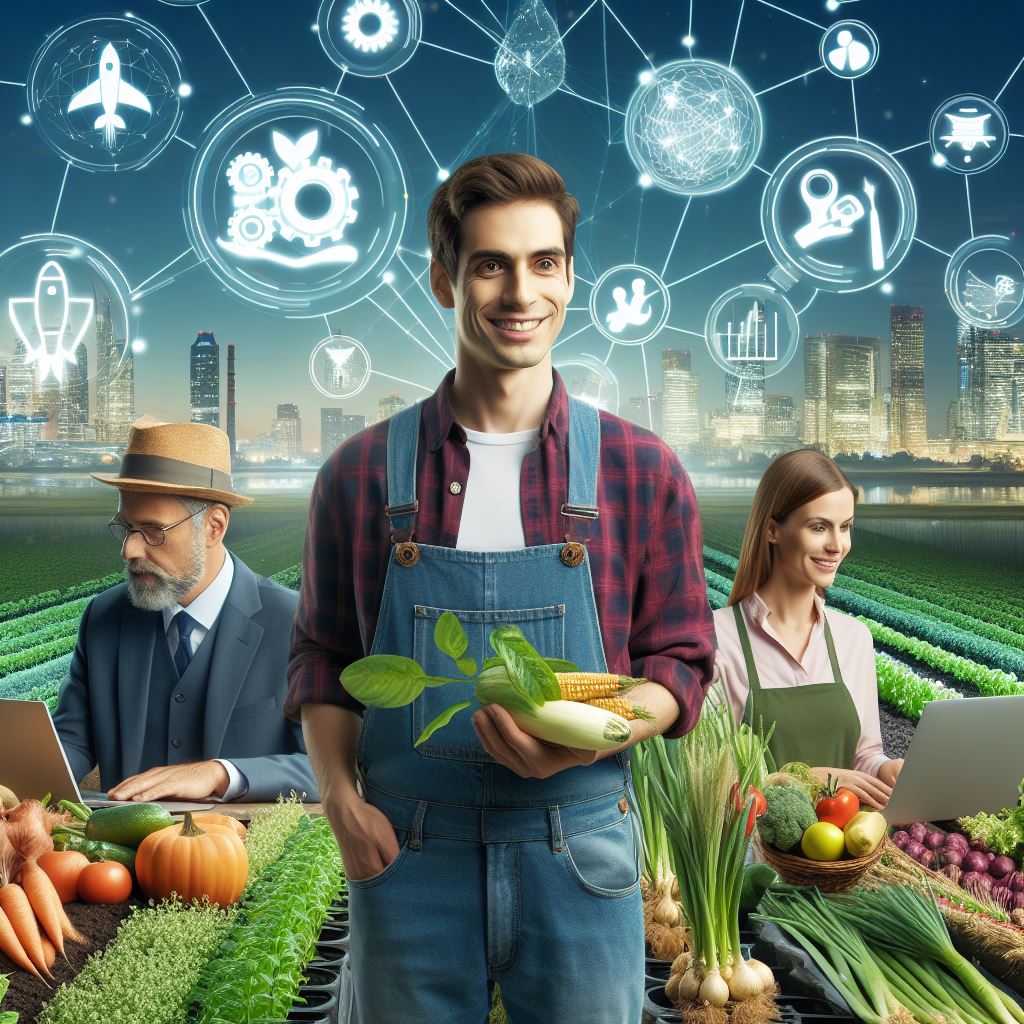Introduction
Crop monitoring plays a critical role in agriculture as it helps farmers identify crop health issues, predict yields, and optimize resource management.
With the advent of agri-tech tools, crop monitoring has become more efficient and accurate.
Agri-tech tools for crop monitoring leverage technologies such as remote sensing, drones, and data analytics to track and analyze crop conditions.
These tools provide real-time information on factors like moisture levels, nutrient content, and pest infestations.
One significant advantage of using agri-tech tools for crop monitoring is the ability to detect problems early on.
By continuously monitoring crops, farmers can identify nutrient deficiencies, diseases, or pest issues before they cause significant damage.
This early detection enables timely interventions, reducing crop losses and improving overall yield.
Agri-tech tools enable precision agriculture. Farmers can use data collected from sensors and satellites to make informed decisions about irrigation, fertilization, and pest control.
This targeted approach minimizes resource wastage and environmental impact, leading to sustainable farming practices.
Agri-tech tools also provide valuable insights for farmers to better understand their fields.
By analyzing historical data and monitoring trends, farmers can fine-tune their cultivation practices, adapt to changing conditions, and improve future crop management strategies.
In essence, crop monitoring is crucial in agriculture for improved decision-making, optimized resource allocation, and increased productivity.
Agri-tech tools have revolutionized this process by offering real-time data, early warning systems, and precision agriculture solutions.
With these tools, farmers can monitor their crops effectively, mitigate risks, and ensure sustainable farming practices.
Traditional Crop Monitoring Methods
Crop monitoring plays a crucial role in agriculture as it helps farmers assess the health and growth of their crops.
Transform Your Agribusiness
Unlock your farm's potential with expert advice tailored to your needs. Get actionable steps that drive real results.
Get StartedOver the years, traditional methods have been used to monitor crops, but they have their limitations and challenges.
Traditional methods used for crop monitoring
- Visual Inspection: Farmers have relied on visual inspection to monitor the health of their crops.
They would walk through their fields, visually inspecting each plant for any signs of disease, pests, or nutrient deficiencies. - Soil Sampling: Another traditional method involves taking soil samples from different areas of the field to assess its nutrient content and pH levels.
This helps farmers determine if any adjustments are needed to optimize crop growth. - Weather Monitoring: Monitoring weather conditions such as temperature, rainfall, and humidity is crucial for assessing the environmental factors that can affect crop growth.
Farmers often rely on weather stations or local meteorological data for this information. - Pest Trap Monitoring: Placing specific traps in the field to catch pests can provide valuable insights into the pest population and help farmers decide on appropriate pest control measures.
The limitations and challenges of these methods
While these traditional methods have been used for decades, they have several limitations and challenges that restrict their effectiveness.
- Time-consuming: Visual inspection and soil sampling are highly labor-intensive tasks, requiring significant time and effort from farmers.
With large fields, it’s challenging to cover every plant or collect enough soil samples for accurate analysis. - Subjectivity: Visual inspection relies on the farmer’s knowledge and expertise to identify signs of disease, pests, or nutrient deficiencies.
This can lead to subjective interpretations and inconsistencies in monitoring. - Limited Coverage: Traditional methods provide a limited scope of information since the assessment is based on a small sample size, whether it’s visual inspection or soil sampling.
This may not accurately represent the entire field’s health and condition. - Delayed Information: Monitoring weather conditions through weather stations or meteorological data can provide valuable insights.
However, delays in obtaining this information can affect timely decision-making and the implementation of necessary actions.
The need for more efficient and accurate tools
Given these limitations, the need for more efficient and accurate tools in crop monitoring becomes evident.
Agricultural technology, or agri-tech, has introduced innovative solutions to address these challenges.
- Remote Sensing: By using satellite imagery or drones equipped with imaging sensors, remote sensing allows farmers to assess the health of crops across large areas.
This provides a more comprehensive and timely overview, identifying potential issues early on. - Internet of Things (IoT): IoT technology enables the collection of real-time data through various sensors placed in the field, including soil moisture sensors, temperature sensors, and humidity sensors.
This data helps farmers make informed decisions about irrigation, fertilization, and pest control. - Machine Learning: With the help of machine learning algorithms, data collected from various sources, including remote sensing and IoT devices, can be analyzed to detect patterns and predict crop health.
This technology reduces the reliance on subjective interpretations and enhances the accuracy of crop monitoring. - Mobile Applications: Agri-tech also offers mobile applications that enable farmers to access real-time information about their crops.
These apps provide personalized recommendations, alerts, and actionable insights, empowering farmers to make informed decisions promptly.
while traditional methods have been the backbone of crop monitoring for many years, they have their limitations.
The introduction of agri-tech tools such as remote sensing, IoT, machine learning, and mobile applications revolutionize crop monitoring by making it more efficient and accurate.
These advancements empower farmers to make informed decisions, optimize crop health, and ultimately improve agricultural productivity.
Read: Water-Saving Tech in Agriculture: Startups to Watch
Overview of Crop Monitoring Tech
When it comes to crop monitoring, there are various agri-tech tools that have revolutionized the industry.
These tools have greatly enhanced efficiency in monitoring crop growth and health, enabling farmers to make more informed decisions.
Various agri-tech tools used for crop monitoring
In this section, we will introduce some of these tools and discuss their advancements and features.
Remote Sensing
- Remote sensing is a technique used in crop monitoring to gather data from a distance.
- It involves the use of satellites and drones to collect images and other information about crops.
- These images can then be analyzed to track changes in crop health, growth, and detect any potential issues.
Crop Sensors
- Crop sensors are devices that measure various parameters of crops, such as moisture levels and nutrient content.
- These sensors can be attached to tractors or other farming equipment to collect real-time data as they move through the fields.
- The data collected by crop sensors can help farmers optimize irrigation, fertilization, and pest control strategies.
Weather Monitoring Systems
- Weather monitoring systems provide farmers with up-to-date and localized weather information.
- By monitoring weather conditions, farmers can anticipate potential risks and take preventive measures.
- These systems often include features like rainfall sensors, wind speed measurements, and temperature gauges.
Automated Irrigation Systems
- Automated irrigation systems eliminate the need for manual irrigation by automatically watering crops.
- These systems use data from sensors and weather monitoring systems to determine the optimal amount of water required.
- By ensuring the right amount of water is delivered to crops, farmers can prevent both over- and under-watering.
Crop Health Monitoring
- Crop health monitoring tools utilize various techniques to assess the overall health of crops.
- These tools can detect diseases, pest infestations, nutrient deficiencies, and other issues affecting crop health.
- By identifying problems early on, farmers can take immediate action to prevent the spread of diseases and minimize yield losses.
- These tools enable farmers to practice precision agriculture, which involves using data-driven insights to tailor farming practices for specific areas within a field.
- This precision allows for efficient use of resources, reduces environmental impact, and maximizes yields.
In short, crop monitoring tech has brought about significant advancements in the agricultural industry.
The tools introduced in this section provide valuable data and insights that help farmers make informed decisions.
As the technology continues to evolve, we can expect even more advanced and efficient tools to further revolutionize crop monitoring and maximize agricultural productivity.
Read: Innovations in Livestock Comfort Control
Types of Crop Monitoring Tech
Remote sensing technologies like satellites and drones
In the dynamic landscape of agriculture, innovative tools are reshaping the way farmers monitor their crops.
Remote sensing technologies, particularly satellites and drones, have emerged as powerful allies in precision farming.
How these technologies provide valuable data for crop monitoring
- Satellites in Crop Monitoring: Satellites orbiting high above provide a bird’s eye view of vast agricultural expanses.
Equipped with advanced sensors, they capture comprehensive imagery, offering insights into various aspects of crop health. - Drones Revolutionizing Precision Agriculture: Drones, or unmanned aerial vehicles, operate at lower altitudes, capturing high-resolution images with remarkable detail.
They bring a granular perspective to crop monitoring, allowing farmers to focus on specific areas promptly. - Valuable Data Acquisition:These technologies play a pivotal role in gathering valuable data for crop monitoring.
Satellites and drones capture imagery that goes beyond the capabilities of the human eye, revealing intricate details crucial for decision-making.
The benefits and drawbacks of remote sensing tech
Benefits of Remote Sensing Tech
- Unparalleled Coverage: Satellites cover vast agricultural landscapes efficiently, enabling farmers to monitor large areas with ease.
This wide-scale observation facilitates the identification of patterns and trends. - Speedy Data Acquisition: Remote sensing provides near real-time data.
Satellites, in particular, capture frequent images, offering a dynamic understanding of crop conditions and changes over time. - Early Issue Detection: The ability to detect signs of diseases, pests, or nutrient deficiencies early on empowers farmers to take proactive measures.
This preventive approach safeguards the current harvest and ensures sustainable farming practices.
Drawbacks of Remote Sensing Tech
- Weather Dependency: One limitation is the reliance on weather condition. Cloud cover can obstruct satellite imagery, reducing the frequency and accuracy of data collection.
- Cost Barriers:The initial costs associated with acquiring and interpreting remote sensing data can be prohibitive, especially for smaller farmers with limited resources.
- Operational Challenges with Drones: While highly effective, drones face operational challenges such as flight restrictions, battery limitations, and the need for skilled operators.
In a nutshell, the integration of remote sensing technologies marks a transformative phase in crop monitoring.
While challenges exist, the benefits in terms of coverage, speed, and early issue detection make these tools indispensable for the future of agriculture.
The marriage of agri-tech and crop monitoring ensures a more resilient, sustainable, and productive farming landscape.
Read: Data-Driven Livestock Nutrition Plans
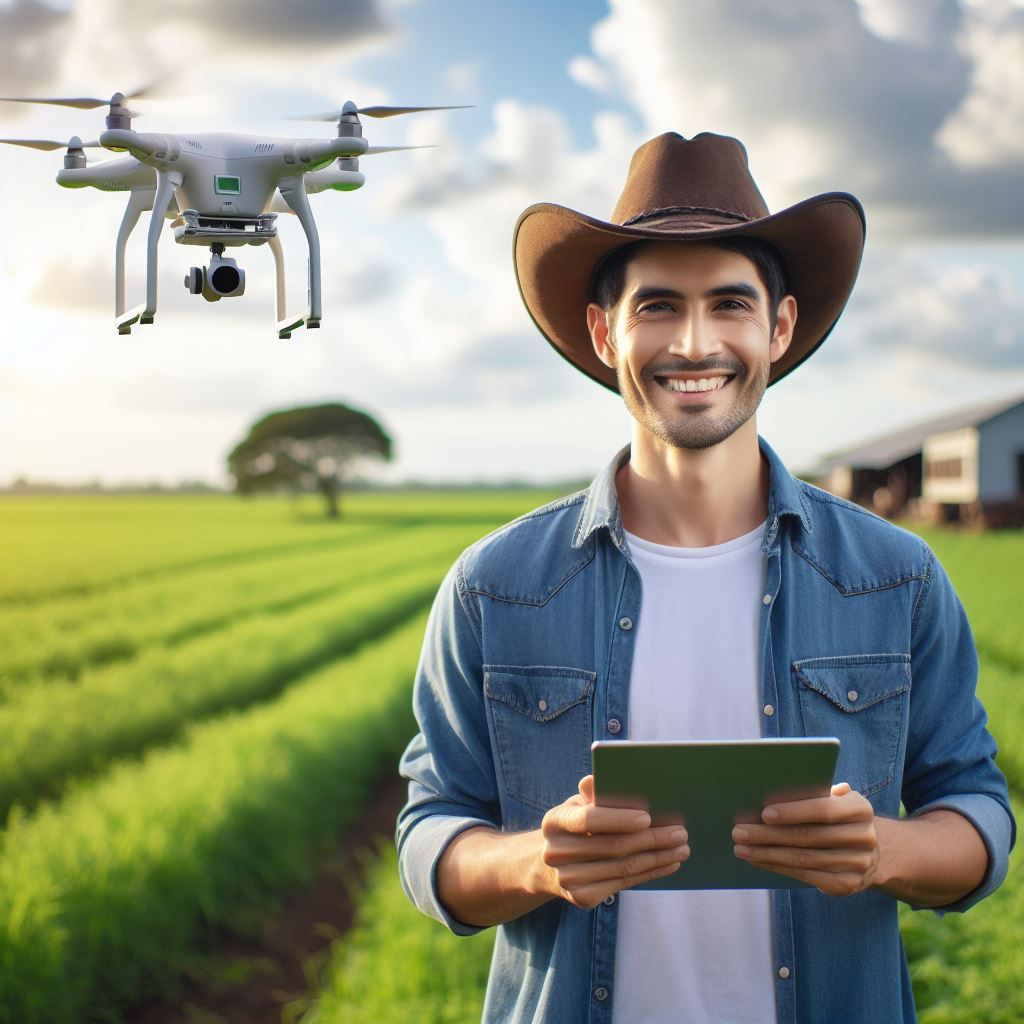
Sensor-based Crop Monitoring Tech
In today’s rapidly advancing world of agriculture, farmers are increasingly turning to sensor-based crop monitoring technology.
These sensors play a crucial role in providing valuable data insights and helping to optimize farming practices.
Use of Sensors for Crop Monitoring
- Sensors are utilized to gather data on various aspects of crop growth and environmental conditions.
- These sensors record and transmit information such as moisture levels, temperature, light intensity, and nutrient content.
- The data collected by sensors is vital for farmers to make informed decisions about their crops.
- By monitoring crop health and growth in real-time, farmers can identify potential issues before they escalate.
- With the help of sensors, farmers can take proactive measures, optimize crop yield, and minimize resource wastage.
Different Types of Sensors Used
- Moisture Sensors: These sensors measure soil moisture levels, providing crucial information for irrigation management.
- Temperature Sensors: Temperature sensors monitor both air and soil temperatures, aiding in proper crop growth and disease control.
- Light Intensity Sensors: These sensors measure the amount of light reaching the crops, assisting in optimizing photosynthesis and artificial lighting usage.
- Nutrient Sensors: Nutrient sensors analyze the nutrient content in the soil, helping farmers optimize fertilizer application.
- Weather Sensors: Weather sensors provide data on meteorological conditions like rainfall, wind speed, and humidity, allowing farmers to make weather-sensitive decisions.
Precision Farming and Resource Optimization
The utilization of sensors in crop monitoring significantly contributes to precision farming and resource optimization.
Showcase Your Farming Business
Publish your professional farming services profile on our blog for a one-time fee of $200 and reach a dedicated audience of farmers and agribusiness owners.
Publish Your ProfilePrecision Farming
Sensors enable farmers to precisely monitor and analyze crop growth conditions, leading to targeted interventions.
With accurate data on moisture levels, farmers can apply water precisely, avoiding over-irrigation and water wastage.
Temperature sensors help farmers determine suitable planting times and optimize crop varieties for specific temperature ranges.
By monitoring light intensity, farmers can adjust artificial lighting in greenhouses to maximize plant growth and energy efficiency.
Optimal nutrient application based on sensor data prevents excessive fertilization, reducing the adverse environmental impact.
Resource Optimization
Sensors allow farmers to optimize resource allocation by providing real-time insights.
Weather sensors help farmers make informed decisions regarding pest control measures and protect crops from adverse weather conditions.
By using data from various sensors, farmers can develop precise irrigation schedules and reduce water consumption.
Overall, sensor-based crop monitoring enhances efficiency, reduces costs, and minimizes the environmental footprint of agriculture.
Sensors are revolutionizing the field of crop monitoring by providing farmers with accurate and real-time data.
Different types of sensors assist in tracking crucial parameters of crop growth, ultimately enabling precision farming practices.
The integration of sensor technology optimizes resource usage, improves crop yield, and promotes sustainable agricultural practices.
As technology continues to evolve, farmers can expect even more advanced sensors to further enhance their agricultural endeavors.
Read: Tech in Veterinary Care: Modern Approaches
Delve into the Subject: Biotech in Agriculture: A Modern Twist
Data Management and Analysis
In the realm of crop monitoring, data management and analysis play a crucial role in ensuring successful agriculture practices.
Let’s delve into the importance of effective data handling and the impact it has on monitoring crops.
Importance of Data Management and Analysis in Crop Monitoring
- Accurate data management ensures proper tracking and recording of crop-related information.
- Data analysis helps identify patterns, trends, and anomalies, enabling proactive decision-making.
- Efficient data management eliminates manual errors and simplifies the process of data retrieval.
- Timely data analysis assists in predicting potential risks, improving crop yield, and reducing losses.
- Data management enables effective sharing and collaboration between farmers, researchers, and agronomists.
Role of Cloud Computing and AI in Processing and Analyzing Crop Data
- Cloud computing provides a centralized platform for storing, accessing, and analyzing large volumes of crop data.
- AI algorithms can process vast amounts of data rapidly, facilitating quick and accurate analysis.
- Cloud-based AI systems enable real-time data analysis, allowing timely interventions and preventive measures.
- Machine learning algorithms can identify crop diseases, pests, or nutrient deficiencies from collected data.
- Cloud computing and AI simplify data integration from various sources, ensuring comprehensive analysis.
Benefits of Real-time Data for Making Informed Decisions
- Real-time data provides up-to-date information about crop health, soil conditions, and weather patterns.
- With real-time data analysis, farmers can promptly identify and address potential yield-limiting factors.
- Access to real-time data empowers farmers to make informed decisions about irrigation, fertilization, and pest control.
- Real-time monitoring allows for early detection of diseases or pests, preventing large-scale crop damage.
- Real-time data enhances resource allocation, minimizes costs, and optimizes overall farm management.
Ultimately, effective data management and analysis are crucial components of crop monitoring technology.
By leveraging cloud computing and AI, farmers can process and analyze vast amounts of data efficiently.
Real-time data further enhances decision-making abilities, enabling farmers to respond promptly to changes in crop health and environmental conditions.
Embracing these tools empowers farmers to achieve higher crop yields, minimize losses, and ensure sustainable agricultural practices.
Case Studies and Success Stories
Examples of successful implementation of crop monitoring tech
Implementing crop monitoring tech has proven to be successful in various agricultural settings.
Here are a few examples:
- Example 1: Improved Pest Management: In a case study conducted by a leading agri-tech company, farmers in a tomato cultivation area used crop monitoring tools to detect pest infestations early.
With real-time data, they were able to apply targeted pest control measures, resulting in a 30% reduction in pesticide usage and a significant increase in crop yield. - Example 2: Precision Irrigation: A farmer in a water-scarce region utilized crop monitoring tech to monitor soil moisture levels and crop water requirements.
By precisely adjusting irrigation schedules based on real-time data, the farmer experienced a 40% reduction in water usage, while still achieving optimal crop growth and yield. - Example 3: Enhanced Fertilizer Management: A large-scale corn producer adopted an agri-tech tool that provided detailed information about nutrient levels in the soil.
By using this data to optimize fertilizer application, the farmer achieved a 20% reduction in fertilizer usage, minimizing environmental impact and saving costs while maintaining high crop productivity.
Real-life experiences and testimonials from farmers
Real-life experiences and testimonials from farmers further highlight the benefits of using agri-tech tools:
- Farmer Testimonial 1: Sarah Johnson, a vegetable grower, shares her experience with crop monitoring tech:
“With the help of these tools, I could spot plant diseases early and take necessary actions. This saved my crops and improved profitability.” - Farmer Testimonial 2: John Miller, a dairy farmer, explains the impact of agri-tech tools on resource efficiency:
“By tracking the grazing behavior of my cows through satellite imaging, I can allocate grazing areas more effectively, resulting in less waste and improved utilization of available land.”
The impact of agri-tech tools on crop yields and resource efficiency
The implementation of agri-tech tools has had a significant impact on crop yields and resource efficiency:
- Increased Crop Yields: A study conducted by an agricultural research institute analyzed the use of crop monitoring tech on wheat farms.
The findings showed that farms using these tools increased yields by 15% compared to traditional practices, thanks to optimized pest control, irrigation, and nutrient management. - Resource Efficiency: Another research project focused on the use of drones equipped with remote sensing technology to monitor crop health.
The study found that early detection of nutrient deficiencies and diseases allowed farmers to address issues promptly, reducing resource wastage by up to 25% and minimizing yield losses.
Most importantly, these case studies, testimonials, and research studies clearly demonstrate the positive impact of crop monitoring tech on agricultural practices.
By leveraging real-time data and actionable insights, farmers can enhance pest management, optimize irrigation, improve fertilizer usage, and ultimately achieve higher crop yields and resource efficiency.
Conclusion
Crop monitoring technology has revolutionized modern agriculture by providing farmers with efficient and accurate tools to manage their crops.
By integrating satellite imagery, drones, and sensors, farmers can monitor crop health, detect pests and diseases, and optimize irrigation and fertilization.
This technology not only improves productivity and yield but also reduces costs and environmental repercussions.
The significance of crop monitoring technology lies in its ability to empower farmers with real-time data and insights, enabling them to make informed decisions and take timely actions.
The ability to detect early signs of stress, disease, or nutrient deficiencies allows farmers to implement targeted interventions, resulting in higher yields and healthier crops.
The integration of precision agriculture techniques with crop monitoring technology ensures resource optimization and sustainability in farming practices.
As we move towards a more sustainable and efficient agricultural system, it is crucial for farmers and agricultural stakeholders to explore and adopt these advanced tools.
Crop monitoring technology offers immense benefits in terms of increased productivity, reduced environmental impact, and improved food security.
By embracing these tools, farmers can gain a competitive edge in the market and contribute to a more sustainable future.
To fully harness the potential of crop monitoring technology, farmers should seek training and support from agricultural experts and technology providers.
Understanding the capabilities and limitations of these tools will help farmers make the most of their investment and optimize their crop management practices.
In closing, crop monitoring technology is a game-changer in modern agriculture.
It enables farmers to make data-driven decisions, improve crop health, and maximize yield while minimizing environmental impact.
It is time for farmers to embrace these tools and take advantage of the numerous benefits they offer.
By doing so, they can ensure a prosperous and sustainable future for the agricultural industry.

